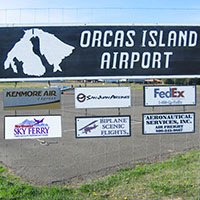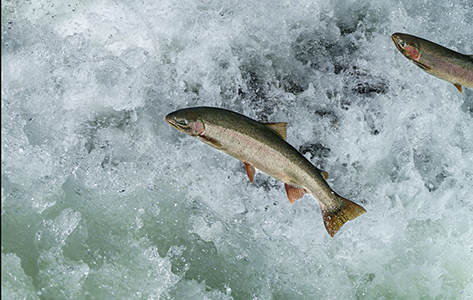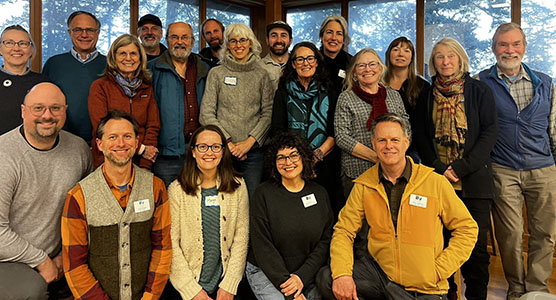–by Matthew Gilbert, Orcas Issues reporter —
The monthly meeting of the Port of Orcas took place on Thursday, September 12, and all commissioners were present for the first time in some months. Following perfunctory approval of fund vouchers and a long discussion with representatives of the Orcas Hangar Association clarifying responsibilities around utility expenses, meter charges, and insurance costs for an onsite bathroom facility, the scheduled 10-minute comment period began which, not surprisingly, extended to an hour.
The issue of the Port’s 20-year Master Plan process has been relatively quiet since reporting on a lightly attended public meeting on June 5 sparked over 90 comments and led to a tense, packed-house gathering on July 26. Since that time, the Port has continued to work with Seattle-based consulting firm DOWL to finalize a “Preferred Alternative” while more than 170 formal public comments have been submitted, approximately two-thirds of which support what has been called Alternative 1 – No Build/No Change. (See Norris Carlson’s summary of those comments and the comments themselves on the Port of Orcas website.)
As it turns out, the Preferred Alternative chosen by the Port is anything but “no change.” It breaks out the 20-year planning process into three phases: Short-term Development (<8 years); Mid-term Development (8 – 19 years); and Ultimate Development (20+ years). Within each timeframe are a range of sub-alternatives, each with potentially significant impacts that nevertheless are defended as meeting FAA requirements and the slow but steady growth of Port traffic. (The final draft of the Master Plan that will be presented at the public meetings on September 19 is available here.)
About a dozen members of the public attended the September 12 meeting. Susan Malins began by reading a letter she submitted to the Port and posted on Orcas Issues about the need to make information readable and easily accessible and to extend the public comment period (past October 5). Charles Toxey asked the Port to sign a letter confirming that “eminent domain” would never be invoked. Norris Carlson then asked the Port to basically walk through their entire decision-making process (e.g., “How did our B-1 airport become ‘non-compliant’ in the first place?”), the objectives driving their decisions (“What is minimally necessary?), and the practical implications of these choices. Board Chair Brian Ehrmantraut, board member Greg Sawyer, and Port Manager Tony Simpson took turns telling the tale. The upshot:
- Not all the changes to the current airport could have been anticipated. Sometimes things “just happen,” e.g., FedEx converting to Cessna Caravans back in 2008 took the airport into B-2 territory.
- The Master Plan is basically a snapshot in time about how to comply with current reality and anticipated changes – which may not actually occur.
- The Plan itself is meant to be “unconstrained” by on-the-ground realities such as County regulations, environmental obstacles, funding challenges, and so on.
- Compliance with the components of the Plan is consequently a goal but not necessarily a final destination (“Nothing has changed in the last 20 years other than some updated safety features . . . and there is no expectation that we will, or want, to do everything in the Plan.”)
- If the “no build” alternative is chosen and the Port leaves the FAA’s AIP (Airport Improvement Program), not only may the Port be liable for monies already invested into it by the FAA but how would it pay for “necessary upgrades,” any or all of which could easily run into the millions?
The final case being made by the Port is that while a majority of the public (at least those who have spoken up) has been strongly against making any changes to the current configuration, “reality” dictates otherwise and it’s not, in the end, the public’s decision to make.
The formal reveal of the Preferred Alternative will take place at two meetings on Wednesday, Sept. 19th: The first is from 1 – 2pm at the Eastsound Fire Station, the second from 5 – 8:30 (with identical presentations by the Port and members of DOWL at 5:30 and 7:30) at the Orcas Center. Public comments will be accepted through October 5, 2018, and must be formally submitted by email to orcasmasterplan@dowl.com or by calling Project Manager Leah Henderson at (425) 869-2670.
**If you are reading theOrcasonian for free, thank your fellow islanders. If you would like to support theOrcasonian CLICK HERE to set your modestly-priced, voluntary subscription. Otherwise, no worries; we’re happy to share with you.**









p.s. A good question for the commissioners and Port manager is what influence did the public feedback process have on the decisions made that are now incorporated in the Preferred Alternative, e.g., What, specifically, was left out, altered, added, or ignored as a result of public input/comments?
If Alternative 1 was never an actual alternative, why was it even included as a possibility?
That’s a very good question. A lot of energy was burned thinking it was a legitimate option.
The commissioners are elected officials.
If they refuse to listen to the community then it’s time to start circulating recall petitions.
As a group we can be sure they are never again allowed a decision making position in our community.
As a collective, we have the teeth, we just need to choose to use them…
Mary, according to the commissioners, Master Plan processes such as these are not supposed to consider constraints (it wasn’t entirely clear why); those apparently come up later when the feasibility of a desired project within the plan is evaluated.
I have never heard of a master plan in ANY context that doesn’t consider constraints. In 50 years. We have several being ignored: the County’s stated refusal to move Mt. Baker road; the County’s stated refusal to allow the Port to reduce the availability of the marina; and the opposition of the bulk of islanders.
Follow the money..
Very good article. Intelligent questions that deserve thoughtful answers because this is more nuanced than we’re being told.
Residents and visitors, concerned Public; please show up today at the 1 pm workshop and/or one of the presentations by DOWL this evening – comment period for this phase is til October 5. Now is the time to ask all the questions we have – and keep asking. We have legitimate constraints – now is not the time to roll over and give up.
It would be nice to see a “stripped down” alternative, meeting only the safety __requirements__, sans new terminal, sans additional hanger space, sans additional tie-downs and especially sans the jet fuel supply. So far as I can determine it would then only include the wider runway and increased taxiway-runway separation. All else seems to be non-essential and focused on airport expansion and not meeting the needs of the existing community.
Basicall, a simple question: Does continued FAA support actually (and where is it documented) REQUIRE the additional facilities?